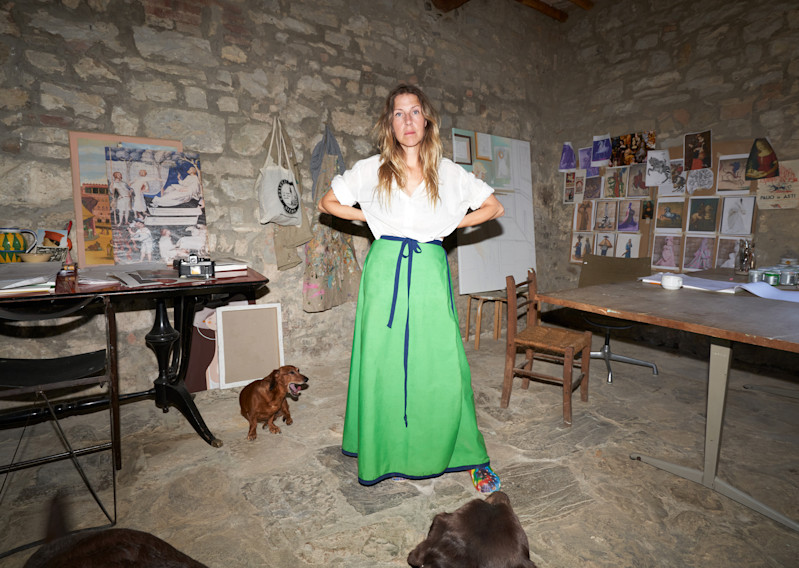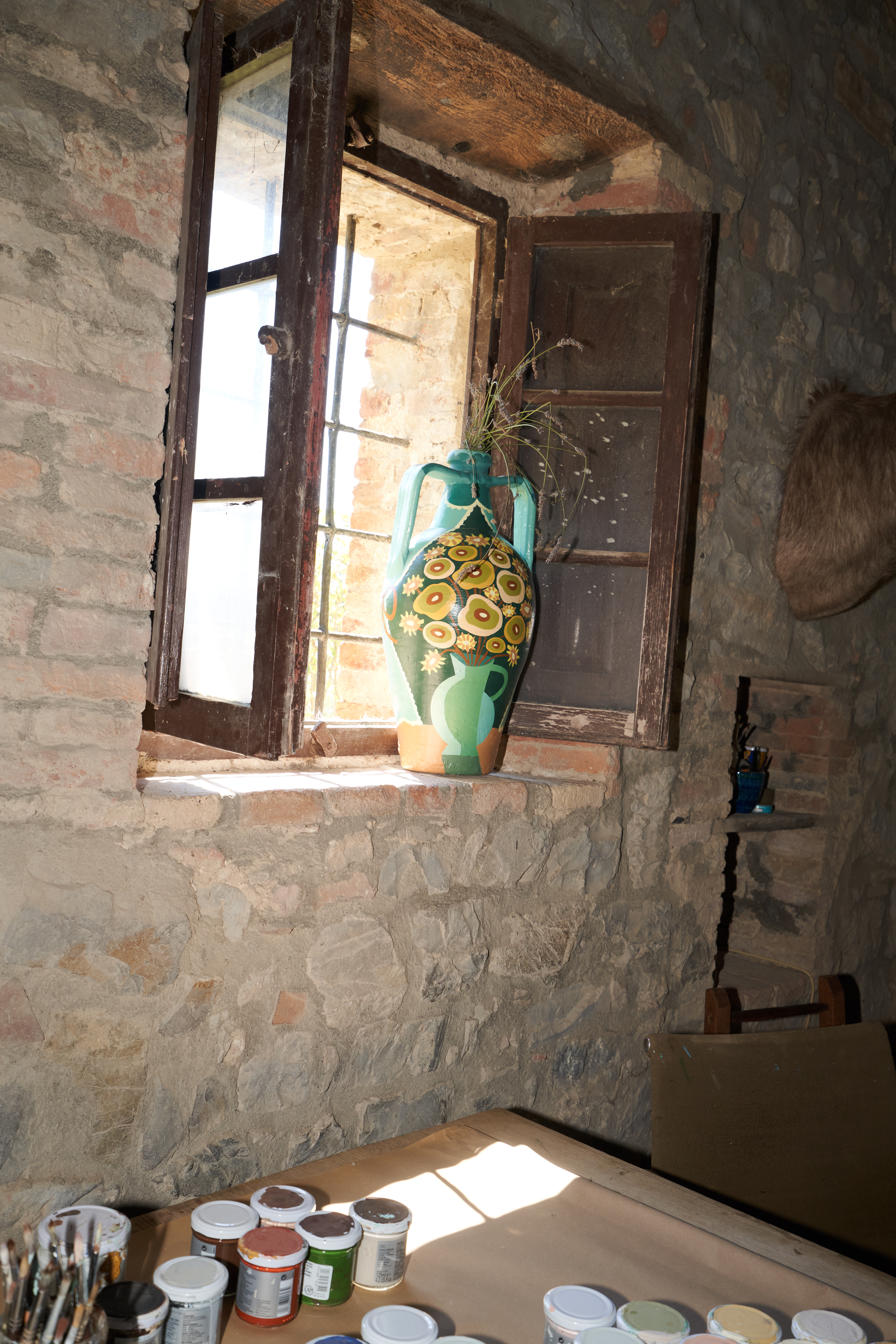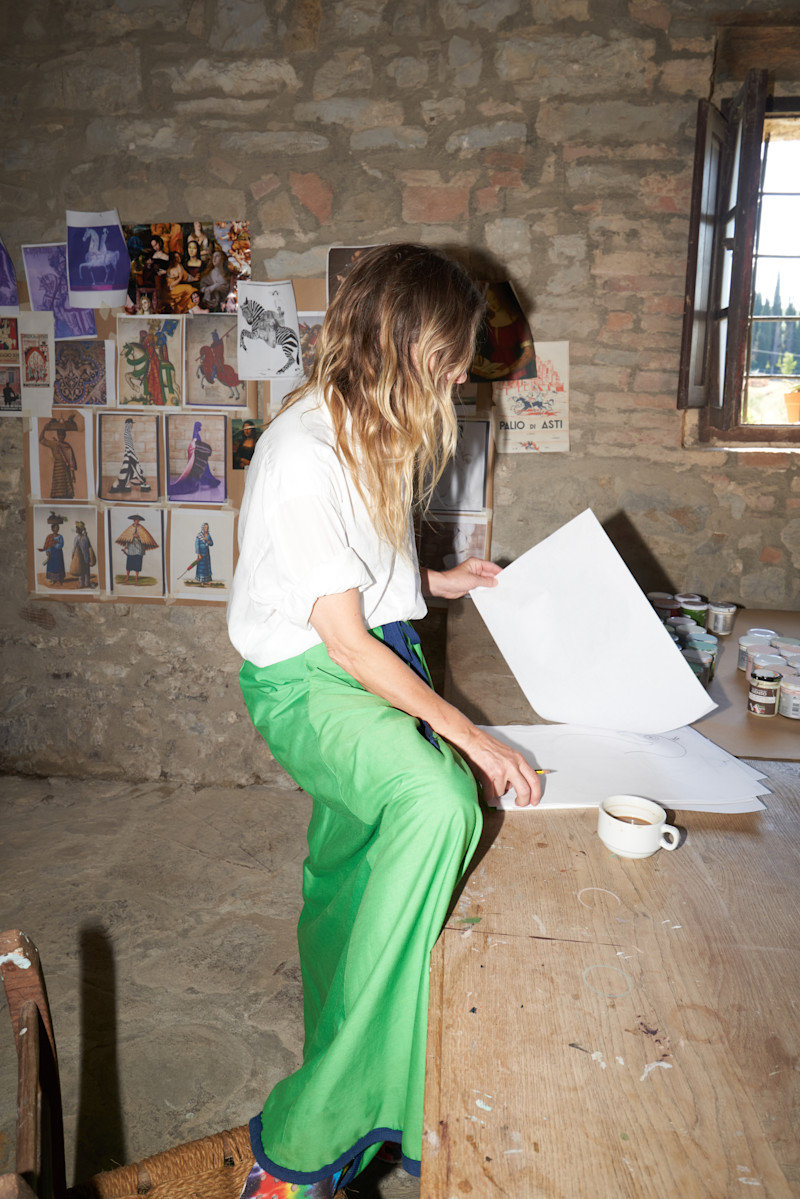Liselotte Watkins in conversation with Michael Storåkers
Interview
September 1, 2022
- Michael Storåkers

Liselotte Watkins in her studio, Siena, Italy
If you’ll allow me to get right to my questions, the title of the exhibition is La Gita (trip/excursion), and that’s also the title of one of the works in the show. How did you arrive at that title?
My own feeling is that I’m making fragmentary excursions to various Italian environments, cultures, and cities. I bring things that I like back, collect them in piles, and then they turn up in my paintings.
It’s a kind of artistic hoarding practice. Who or what is La Gita?
La Gita is less of a “she”, and more of a collection of fates and impressions.

Liselotte Watkins, La Gita, 2022, Acrylic on canvas, 150 x 80 cm
Is it a part of a larger narrative within the exhibition, or are the works best viewed as individual portraits?
This is a story told about allegorical characters. They all matter to the story individually, but they also represent ideas and the symbols that accompany them as objects. I’m not expecting the viewer to grasp all the associations.
Since your very first exhibition at CFHILL in 2016, Portraits, you have been depicting women you’ve encountered in Italy, both in Liselotte Watkins and Sigrid Hjertén (2018) and Altre Stanze (2020). The same is true of your exhibitions at institutions, including the ones at Villa San Michele on Capri in 2019 and Millesgården in Stockholm in 2021. Now, you’ve also relocated from the metropolis of Rome to the countryside of Tuscany. I sense a shift in your use of colour over these four exhibitions at CFHILL; you seem to have transitioned from a dazzling palette to a more earthy set of tones. Is this a result of your move, do you think?
Absolutely. I paint where I stand. Here, in Tuscany, everything is nature, stone houses, and animals. The colours were like a gut punch when I first came to Italy 13 years ago. Now, they’ve quietened down.

Liselotte Watkins Liselottes studio, Siena, Italy
Your palette began to fade while you were still in Rome, during the lockdown and the pandemic. Do you find yourself missing the brighter colours?
Colour often leads the way. I miss the light in Rome, the way it hits the walls of the pink buildings. Sometimes, I miss the ocean, and sometimes, I miss the bright colours of the Memphis group, who worked in Milan. But this is new, and I always enjoy novelty.
Your women seem to radiate courage. Perhaps they arecontemporary versions of the Italian baroque, and the active female figures of Artemisia Gentileschi. Her father was a great Caravaggisti, and her most famous work is Judith Slaying Holofernes. She was the first great female artist in Italy, and she managed to win admiration and respect during her lifetime.How do you relate to the Italian baroque?
After my years in Rome, where I lived in a flat right next to the Galleria Borghese, Bernini had become something of a neighbour to me, whom I could just pop round to see from time to time. Caravaggio was nearby, at the Palazzo Barberini. But for this exhibition, I’ve been looking more to the Spanish painters.Francisco de Zurbarán and his paintings of female saints, and I turned Diego Velázquez’s Las Meninas into my own work Frassi, which is also full of women. I like the baroque, with all its stories, still lifes, and hidden messages. However, when it comes to the body language of these women, they don’t really express the drama of the baroque; they’re more along the lines of the ideals of renaissance or medieval painting.
Which artists do you take inspiration from?
I just saw an exhibition at the Peggy Guggenheim Collection in Venice, Surrealism and Magic. It featured works by Leonor Fini and Leonora Carrington, paintings they had both charged with meaning and mystique. That inspired me.
Are the women in your works autobiographical?
No, they are a fantasy. One leads on to the next, and a narrative begins to take shape around the ways they relate to one another, and the things they do every day.

Liselotte Watkins Frassi 2022 Acrylic on canvas 160x210 cm
Do you find weakness unattractive in women?
I don’t necessarily think of these women as strong. They’re complex; weighed down by their Italian heritage and the challenge of breaking with tradition. They’re all trying to keep up with the times in some way or other, but it’s not quite working out. I’ve spent my whole life striving for strength. I admire people who possess it, but some of us have to work harder to achieve it than others. I want the women in my works to be unstrained, rather than strong.
In past exhibitions, you’ve focused on anxious women, both in your dialogue with Sigrid Hjertén and in your women of San Michele. What are these women all about?
On San Michele, they were restless and bored. They needed some kind of release. In Sigrid, I saw a strong person who made her way through tremendous difficulties. I tried to paint women who would exhibit both these qualities. The current exhibition, again, reflects a complexity in women, one that I see and recognise in myself.

Liselotte Watkins in her studio, Siena, Italy
Where are all the men? Was it only your son Wim, and some of your friends’ sons, who made the cut?
Naomi Itkes’s son Noah was included. I’ve also painted my son Wim a lot. But this particular story is only about women.
Your last exhibition featured interiors. Now, we’ve moved outside, often on horseback. How did the horses enter the picture?
The simple response is that my daughter has taken up riding, and that I’m now spending five evenings a week in the stables. Horses are timeless, somehow, and my women needed some kind of transportation in order to get out into the world.
What about the wooden structures? Don Quixote?
They’re taken from an exhibition of Domenico Gnoli’s works at Fondazione Prada in Milan. I felt that this tiny, tiny sketch he made of sticks resounded with the hiking sticks I had added to my own works. It turned into something reminiscent of the Blair Witch Project–a little scary, but also quite naïve.
Have you found it challenging to scale up to larger canvases?
No. I had a lot to fit in. It was really just a matter of having enough space for them in my new studio. I’ve been wanting to do it for a long time.


